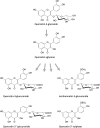Plant science and human nutrition: challenges in assessing health-promoting properties of phytochemicals
- PMID: 21803940
- PMCID: PMC3226206
- DOI: 10.1105/tpc.111.087916
Plant science and human nutrition: challenges in assessing health-promoting properties of phytochemicals
Abstract
The rise in noncommunicable chronic diseases associated with changing diet and lifestyles throughout the world is a major challenge for society. It is possible that certain dietary components within plants have roles both in reducing the incidence and progression of these diseases. We critically review the types of evidence used to support the health promoting activities of certain phytochemicals and plant-based foods and summarize the major contributions but also the limitations of epidemiological and observational studies and research with the use of cell and animal models. We stress the need for human intervention studies to provide high-quality evidence for health benefits of dietary components derived from plants.
Figures


References
-
- Ahuja D., Sáenz-Robles M.T., Pipas J.M. (2005). SV40 large T antigen targets multiple cellular pathways to elicit cellular transformation. Oncogene 24: 7729–7745 - PubMed
-
- Akhtar S., Meeran S.M., Katiyar N., Katiyar S.K. (2009). Grape seed proanthocyanidins inhibit the growth of human non-small cell lung cancer xenografts by targeting insulin-like growth factor binding protein-3, tumor cell proliferation, and angiogenic factors. Clin. Cancer Res. 15: 821–831 - PubMed
-
- Albanes D., et al. (1996). Alpha-tocopherol and beta-carotene supplements and lung cancer incidence in the alpha-tocopherol, beta-carotene cancer prevention study: Effects of base-line characteristics and study compliance. J. Natl. Cancer Inst. 88: 1560–1570 - PubMed
-
- Al Janobi A.A., Mithen R.F., Gasper A.V., Shaw P.N., Middleton R.J., Ortori C.A., Barrett D.A. (2006). Quantitative measurement of sulforaphane, iberin and their mercapturic acid pathway metabolites in human plasma and urine using liquid chromatography-tandem electrospray ionisation mass spectrometry. J. Chromatogr. B Analyt. Technol. Biomed. Life Sci. 844: 223–234 - PubMed
-
- Astley S.B., Elliott R.M., Archer D.B., Southon S. (2004). Evidence that dietary supplementation with carotenoids and carotenoid-rich foods modulates the DNA damage: Repair balance in human lymphocytes. Br. J. Nutr. 91: 63–72 - PubMed
Publication types
MeSH terms
Substances
LinkOut - more resources
Full Text Sources
Other Literature Sources
Medical

